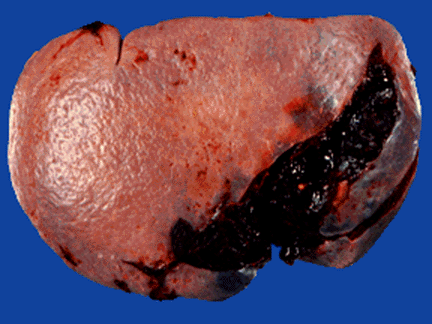There is a significant amount of variation in the management of pediatric solid organ injury. This is well documented between adult and pediatric trauma centers in t, but also apparently between centers in different countries. A poster from a Japanese group in Okinawa Japan will be presented this week detailing the relationship between contrast extravasation after spleen or liver injury and pseudoaneurysm formation.
In adults, the general rule is that pseudoaneurysms just about anywhere slowly enlarge and eventually rupture. This group sought to define this relationship in the pediatric age group. They performed a multi-center observational study of retrospectively enrolled children, defined as age 16 and less. Those who had contrast extravasation on initial CT were monitored for later pseudoaneurysm formation.
Here are the factoids:
- 236 patients were enrolled across 10 participating centers, with about two-thirds having liver injury and the remainder with splenic injury
- 80% of patients underwent followup CT scan (!!)
- 33 patients (15%) underwent angiography (!!!!)
- 17 patients with CT scan (2%) had pseudoaneurysm formation and 4 of them had a delayed rupture
- Overall, pseudoaneurysms occurred in 29% of those with contrast extravasation and 5% without extravasation
- The authors concluded that contrast extravasation was significantly associated with pseudoaneurysm formation after adjusting for variables such as ISS, injury grade, and degree of hemoperitoneum
Bottom line: This is an abstract, so a lot is missing. What was the age distribution, especially among those who underwent angiography? Was the data skewed by a predominantly teenage population, whose organs behave more like adults? The abstract answers a question but ignores the clinical significance.
For those trauma professionals who routinely care for pediatric patients, you know that contrast extravasation in children doesn’t act like its adult counterpart. Kids seldom decompensate, and for those who are mistakenly taken for angiography, the extravasation is frequently gone. The authors even admitted in the conclusion that aggressive screening and treatment for pseudoaneurysm was carried out.
The real question is, what is the significance of a solid organ pseudoaneurysm in children? Based on my clinical experience and reading of the US literature, not much. Of course, there is a gray zone as children move into adulthood in the early to mid-teens. But this does not warrant re-scanning and there should be no routine angiography in this age group. Contrast extravasation in pediatric patients warrants close observation for a period of time. But intervention should only be considered in those who behave clinically like they have ongoing bleeding.
Reference: Association between contrast extravasation on CT scan and pseudoaneurysm in pediatric blunt splenic and hepatic injury: a multi-institutional observational study. Poster 31, AAST 2018.


